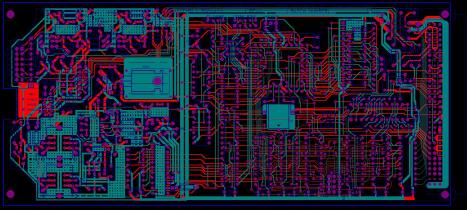
|

I've described elsewhere how we at Heads Up Technologies cooperated with Luminator, Inc., to get a foot-hold in transportation industry. Basically, we provided audio annunciators (our LVA product) and "next stop" systems (our LVA-NS product) to Luminator (www.luminatorusa.com), who marked the products as their own and resold them for installation in buses.Eventually, Luminator decided that their profits would be enhanced by designing their own next-stop system rather than reselling ours. The product Luminator designed for this purpose was designated the Semi-Automatic Next-Stop (SANS).
However, Luminator did not choose to completely eliminate Heads Up's participation, but rather called upon us to design and manufacture some of the circuit boards for the SANS unit. One such board, the Integrated Voice Annunciator (IVA) was completely designed by me. Another, the audio-amp circuit board (IPA), was done by another designer at Heads Up, so I won't discuss it further.
The function of the circuit board, very simply, was to act as an audio-playback unit for the SANS. The SANS stored audio data (in my proprietary compression format) within the file-system in its own flash memory, and transferred this data to the IVA card somewhat in real-time during normal execution. The IVA was expected to receive this data, buffer it as necessary, uncompress it, and to play it back (i.e., deliver it to an audio amp).
Though merely a single circuit board, the IVA project has some interesting characteristics:
The IVA was later used within Heads Up's own PBS-650 passenger briefing system product.It was the first design I had done, other than the aborted 3M infusion pump project, intended to coexist intimately within someone else's design, rather than being essentially a stand-alone design. This also required very close cooperation with the customer, using their electrical requirements, their communication protocols, their database formats, etc., rather than relying upon my own. It was also the first case in which any of my designs had been reviewed at the board level (as opposed to the unit level) by customers. I was forced, for example, to make minor modifications to correspond to certain customer-imposed standards. It was the highest-speed hardware I had designed to that point, being at the limit of what was then achievable with the 8051 MPU family.